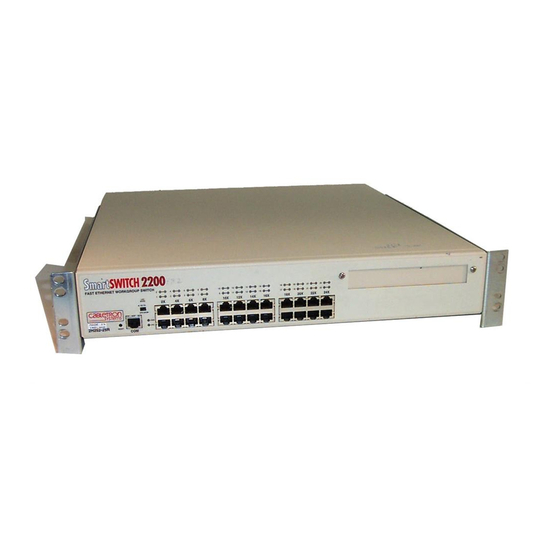Table of Contents
Advertisement
Quick Links
Download this manual
See also:
User Manual
Advertisement
Table of Contents

Summary of Contents for Enterasys SmartSwitch 2H252
- Page 1 IP TOS Supplement for Local Management User’s Guides 9033559-01...
- Page 3 Enterasys Networks and its licensors reserve the right to make changes in specifications and other information contained in this document without prior notice. The reader should in all cases consult Enterasys Networks to determine whether any such changes have been made.
- Page 5 This supplement supersedes the information in the Priority Classification Configuration section in the following documents: • SmartSwitch Series 2E253, 2H252, 2H253 and 2H258 Local Management User’s Guide (9033069) • MATRIX E7 Series and SmartSwitch 6000 Series Modules (6x2xx and 6x3xx) Local Management User’s Guide (9034046-02)
-
Page 6: Priority Classification Configuration Screen
This IP TOS Rewrite feature enables a Network Administrator to assign Layer 3 TOS characteristics to incoming frames and set the switch to rewrite the 8-bit TOS value in the Layer 3 information portion of incoming frames. The SmartSwitch/Matrix products enable you to configure the switch to: •... -
Page 7: Screen Example
Screen Example Figure 2 Priority Classification Configuration Screen Field Descriptions Refer to Table 1 for a functional description of each screen field. Table 1 Priority Classification Configuration Screen Field Descriptions Use this field … To… Display the Priority Identifiers (PIDs) currently associated with (Selectable) –... - Page 8 Table 1 Priority Classification Configuration Screen Field Descriptions (Cont’d) Use this field … To… Enter the priority value that will be associated with the classification (Modifiable) – selected in the Classification field. A PID from 0 to 7 may be typed bottom of screen into the field, where 0 is the lowest priority and 7 is the highest priority.
- Page 9 Table 2 provides a list of the classifications that can be selected in the Classification field and the associated subclassifications. Table 2 Classification List Classification Ethernet II Type> 802.3 SAP> New IP TOS: - NO CHANGE - TOS=PID - CUSTOM> Same Same Same...
- Page 10 Table 2 Classification List (Cont’d) Classification IP Protocol Type New IP TOS: - NO CHANGE - TOS=PID - CUSTOM> IPX COS IPX Packet Type Src IP Address New IP TOS: - NO CHANGE - TOS=PID - CUSTOM> Subclassification and Options IP Protocol Type: TOS: Value = 0x00 - UDP...
- Page 11 Table 2 Classification List (Cont’d) Classification Dest IP Address New IP TOS: - NO CHANGE - TOS=PID - CUSTOM> Bil IP Address New IP TOS: - NO CHANGE - TOS=PID - CUSTOM> Src IPX Network Dest IPX Network Bil IPX Network Subclassification and Options IP Address:...
- Page 12 Table 2 Classification List (Cont’d) Classification Src UDP Port New IP TOS: - NO CHANGE - TOS=PID - CUSTOM> Same Same Same Same Same Same Same Same Same Same Same Same Same Same Same Same Dest UDP Port Same New IP TOS selection as for Src UDP Port Bil UDP Port...
- Page 13 Table 2 Classification List (Cont’d) Classification Src TCP Port New IP TOS: - NO CHANGE - TOS=PID - CUSTOM> Same Same Same Same Same Same Same Same Same Same Same Same Same Same Same Same Dest TCP Port Same New IP TOS selection as for Src TCP Port Bil TCP Port...
- Page 14 Table 2 Classification List (Cont’d) Classification Src IPX Socket Dest IPX Socket Bil IPX Socket Src MAC Address Dest MAC Address Bil MAC Address IP Fragments New IP TOS: - NO CHANGE - TOS=PID - CUSTOM> Subclassification and Options IPX Socket: - NCP - SAP - RIP...
- Page 15 Table 2 Classification List (Cont’d) Classification IP Fragments New IP TOS: - NO CHANGE - TOS=PID - CUSTOM> Dest UDP Range Same New IP TOS selection as for Src UDP Range Bil UDP Range Same New IP TOS selection as for Src UDP Range Src TCP Port New IP TOS:...
-
Page 16: Classification Precedence Rules
Classification Precedence Rules NOTE: It is important that you have a comprehensive understanding of the precedence concept before configuring the switch, as these rules can have a significant impact on the network operation. When there are multiple classifications assigned to a switch, the switch must determine which classification takes precedence according to the Classification Precedence Rules. - Page 17 Table 3 Classification Precedence (Cont’d) Classification Type Layer 3 IP TOS IP Type IPX COS IPX Type Layer 3 Source IP Address Exact Match Source IP Address Best Match Destination IP Address Exact Match Destination IP Address Best Match Source IPX Network Number Destination IPX Network Number IP Fragments Precedence Level...
- Page 18 3. This is because the TCP port number classifications take precedence over IP TOS classifications. The key thing to remember is that the switch will classify frames based on one of the classification options. Precedence Level...
-
Page 19: Displaying The Current Pid/Classification Assignments
Displaying the Current PID/Classification Assignments To see which ports are set to a particular PID/Classification (Classification Rule), the Protocol Port Configuration screen must be displayed. To access the Protocol Port Configuration, proceed as follows: 1. Use the arrow keys to step to the line with the Classification Rule of interest. 2.













Need help?
Do you have a question about the SmartSwitch 2H252 and is the answer not in the manual?
Questions and answers